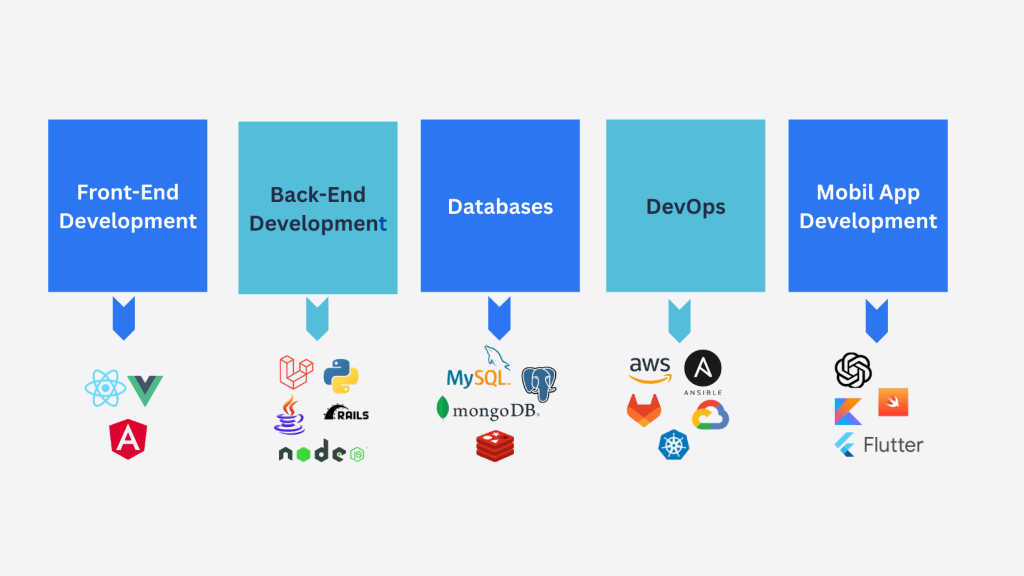CXBOS Insights
Your daily dose of news, insights, and information.
Code All the Things: Inside the Mind of a Full-Stack Developer
Unleash your inner coder! Discover the secrets of a full-stack developer's mind and elevate your skills to the next level.
The Full-Stack Developer's Toolkit: Essential Skills and Tools You Should Master
In today's rapidly evolving tech landscape, being a Full-Stack Developer means mastering a myriad of skills and tools across both front-end and back-end development. At the core of this toolkit are languages such as HTML, CSS, and JavaScript for front-end development, which enable developers to create visually appealing and interactive user interfaces. On the back end, proficiency in languages like Python, Ruby, or Java is critical for handling server-side logic. Additionally, familiarity with frameworks such as React, Node.js, or Django can significantly enhance productivity, allowing developers to streamline their workflow and improve code quality.
Beyond programming languages, a Full-Stack Developer should also be well-versed in tools that promote collaboration and project management. Version control systems like Git are essential for tracking changes and collaborating with other developers. Testing frameworks and tools such as Jest and Selenium are indispensable for ensuring high-quality code. Furthermore, understanding deployment processes and tools like Docker or Kubernetes will facilitate smoother deployment cycles. In summary, mastering these essential skills and tools not only enhances a developer's versatility but also helps in building robust and efficient applications.

Navigating the Stack: A Day in the Life of a Full-Stack Developer
A day in the life of a full-stack developer is both dynamic and challenging, as these professionals navigate the intricate layers of both front-end and back-end development. The morning often begins with a brief team stand-up meeting, where developers share updates on their projects, discuss obstacles, and set the day's priorities. Following this, a full-stack developer may dive into coding, utilizing languages such as HTML, CSS, and JavaScript for the front-end, and Node.js or Ruby on Rails for the back-end. This blend of skills allows them to understand how various components of an application interact, leading to more efficient troubleshooting and development.
As the day progresses, a full-stack developer frequently collaborates with designers and product managers to ensure the user experience is seamless. They might find themselves switching between tasks, attending meetings, and writing documentation, all while keeping the project timeline on track. By the afternoon, testing becomes a crucial focus; they conduct unit tests and bug fixes to ensure the application runs smoothly. Ultimately, the role of a full-stack developer is essential in bridging the gap between the visual elements of a website and its underlying functionalities, making every day a unique blend of creativity and technical innovation.
Common Challenges Faced by Full-Stack Developers and How to Overcome Them
Full-stack developers often encounter a variety of challenges that can hinder their productivity and effectiveness. One common issue is the overwhelming breadth of knowledge required to excel in both front-end and back-end technologies. Developers must stay updated with numerous programming languages, frameworks, and tools, which can lead to a feeling of being constantly behind. To tackle this challenge, it is crucial for full-stack developers to prioritize and specialize in certain areas while remaining aware of the broader landscape. Setting aside time for continuous learning and choosing specific technologies to master can significantly reduce the cognitive load.
Another significant challenge faced by full-stack developers is the lack of clear communication within teams, particularly if team members are specialized in either front-end or back-end development. This disconnect can lead to inefficiencies and misunderstandings during the development cycle. To overcome this, it is essential for full-stack developers to facilitate regular meetings and encourage open dialogue among team members. Implementing collaborative tools for project management and code sharing can further bridge the gap, ensuring that everyone is aligned and working towards the same goals.